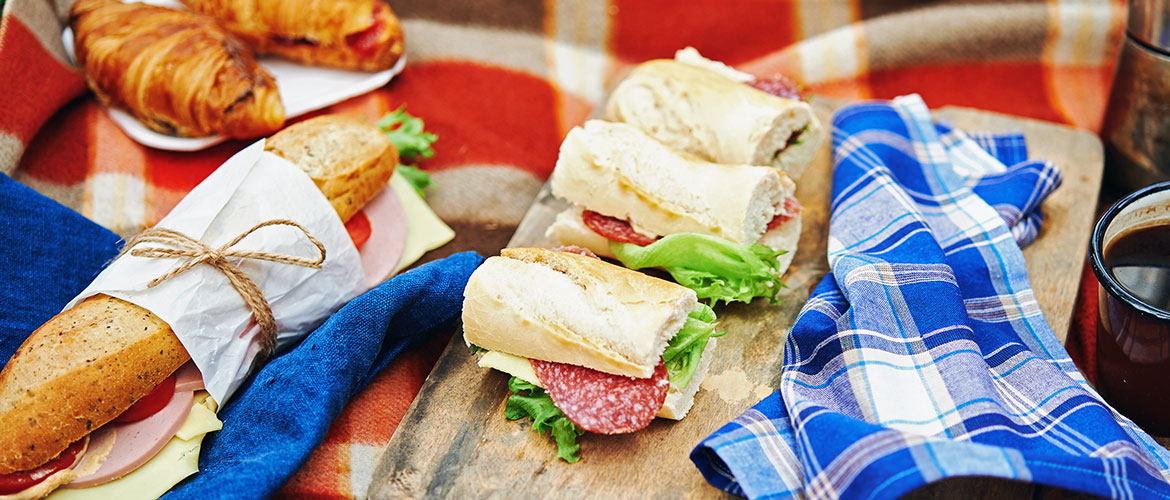Nothing says “Hello, summer!” like a picnic in the sun. But after a long hike on Father’s Day or an afternoon at the park on a warm Saturday in June, food safety concerns can often trump the welcoming summer feelings. Picnic favorites such as potato salad, fried chicken, deviled eggs or pulled pork tend to be high-risk foods ̶ they contain large amounts of protein and water, a perfect breeding ground for bacteria at warm weather temperatures. However, lower-risk food options such as potato chips, toaster pastries and baked goods don’t always fit into a healthy food model. Planning and packing properly can help you and your family make healthy picnicking choices and outwit food-borne illness threats.
PACK
- Gather the Right Gear: Start every picnic by gathering a cooler large enough to safely store food and plenty of ice (keeping foods out of the temperature danger zone, 40-140°F, is the number one step in keeping foods safe). Hand sanitizer or wipes are also important to pack especially when serving or eating with your hands.
- Menu Plan with MyPlate: The United States Department of Agriculture’s (USDA) healthy eating icon, MyPlate from choosemyplate.gov, can serve as the perfect packing list. Plan meals using each of the Five Food Groups (whole grain rolls, dried fruit and nut trail mix, string cheese and pre-sliced fruits and vegetables).
- Take Advantage of Fresh Summer Produce. Farmer’s markets, backyard gardens and grocery store shelves are bountiful with seasonal fruits and vegetables especially in the warmer months. Fruits and vegetables are nutrient and fiber-rich and add color to your picnic spread. To keep them safe, avoid adding sugar, mayonnaise or whipping cream before a picnic. Instead, enjoy vegetables with yogurt-based dipping sauce, like Tzatziki Sauce (prepared just prior to heading out, and kept cool until serving) or enjoy hard fruits like apples, pears and pineapple on skewer sticks.
- Pack Fresh, Local Dairy Products Safely: Don’t miss out on refreshing and refueling chocolate milk, yogurt cups or protein-rich cheeses during a picnic. Dairy products, along with other foods are safe to eat when kept below 40°F in a cooler with ice.
PICNIC
- Day Time Dining: Most picnics tend to be a very social activity which often include light grazing and/or heavy appetizers. Be food-borne illness conscious by keeping track of the amount of time that appetizers stay outside of the cooler (below 40°F). Unpreserved foods should be thrown away if they have been out of the danger temperature zone for over two hours, or if cumulatively, they have been in the danger zone for four hours. The USDA recommends only keeping perishable foods out for one hour if the outside temperature is over 90°F. Chip dips are a perishable food that are popular to share. Lighten up this appetizer by mixing softened cream cheese with salsa and serve with carrot sticks or enjoy pre-sliced Fruit and Cheese slices.
- Grab and Go: Picnics are a great excuse to ditch the silverware and enjoy tasty foods that can be eaten with your hands. Keeping hands clean is important for preventing food borne illness, even at a picnic. Pack baby wipes, antibacterial wipes or sanitizers whenever you pack grab-and-go snack foods. Fruit and cheese kabobs or healthy wraps are great options that don’t require any cooking. Pre-make wraps by rolling deli meat, slices of cheese, lettuce, carrots, cucumbers or any other healthy add-ins in a whole-wheat tortilla. Wait to add spreads until right before serving; most spreads are considered high-risk foods and are more susceptible to contamination. Take along flavorful yogurt dip for dipping your wrap or sandwich.
- Single Servings: On particularly active days, pack a backpack with single-serve options. Keep foods cool in a freezer until the last minute. Then add a few ice packs to the bottom of a backpack. Try pre-making fruit and yogurt smoothies and freezing them the night before in easy- to-carry containers. As the frozen smoothies melt, they become the perfect refreshing refuel drink with carbohydrate for energy and protein for muscle rebuilding. Foods that don’t require refrigeration like these Banana Walnut Muffins are easy to throw in a backpack as well.
- Healthy Dessert: Ice cream can be hard to keep cold in a cooler without dry ice. Try substituting vanilla yogurt for ice cream.
- Packing Up: There are multiple recommendations for storing leftovers, but when cleaning up a picnic, a general rule of thumb is that leftover foods can be stored in the refrigerator for three to four days. Only take home foods that were appropriately kept out of the danger temperature zone during a picnic; a food thermometer is the only way to appropriately assess this. For more information about storage and safe food handling visit the USDA website.
Picnics can be healthy and tasty with a little bit of planning, even if you aren’t preparing food on-site. Planning ahead, keeping foods cool and out of the danger zone, and serving foods within two hours of taking them out of a cooler are all easy steps to take to help ensure your next picnic is free from food-borne illness. Enjoy your next day outside by refueling with Five Food Group-based meals that are sure to impress and leave great memories with your friends and family.




